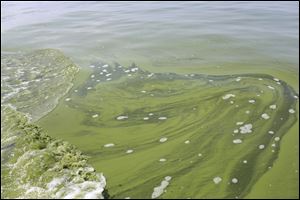
Data shows Lake Erie impairment declaration was justified in 2010
4/13/2018Although Ohio has joined Michigan in declaring the open waters of western Lake Erie as impaired, new data shows there was scientific justification to do that as far back as 2010 — four years before the Toledo water crisis.
The data was generated for the Ohio Environmental Protection Agency after the U.S. EPA told the state agency back in January to rethink the Kasich administration’s steadfast refusal over many years to declare the open water as impaired. The administration’s reversal on that front undoubtedly will mean unprecedented controls on agriculture and tighter sewage regulations.
Tim Davis, a former National Oceanic and Atmospheric Administration algae researcher in Ann Arbor, told attendees of the annual Lake Erie Foundation conference that the science — though not developed until a few weeks ago — shows the lake’s open water should have been declared impaired in 2010.

Algae in the Toledo area reached a crisis point in August, 2014.
The conference was held Thursday at W.W. Knight Nature Preserve.
Mr. Davis explained a complicated formula he and other algae researchers were asked to develop by the Ohio EPA once it looked like the U.S. EPA was headed toward defeat in the lawsuit brought against it by the Chicago-based Environmental Law & Policy Center on behalf of Toledo-based Advocates for a Clean Lake Erie.
The formula has a metric scientists developed for determining years in which algal blooms grow particularly strong. Once at least two years of excessive blooms have been documented over a consecutive six-year period, then the impairment declaration should have been made. That was back in 2010, said Mr. Davis, also a Bowling Green State University algae researcher.
Joining Mr. Davis in developing that protocol were BGSU algae colleagues George Bullerjahn and Mike McKay, as well as Tom Bridgeman, University of Toledo algae specialist and newly named director of UT’s Lake Erie Center; Justin Chaffin, who heads algae research for Ohio Sea Grant and Ohio State University’s Stone Laboratory, and others. The work was done in collaboration with the Ohio EPA and the U.S. EPA, Mr. Davis said.
“It was the lawsuit that caused this [research project],” Mr. Davis added. “Even though they [the Ohio EPA] weren’t defendants, they were getting heat from the U.S. EPA.”
Lake Erie has more than 200 types of algae. Most of it — especially that known as diatoms — are healthy and contribute to the food chain.
Even small blooms of the bad stuff — microcystis and other forms of cyanobacteria classified as harmful algal blooms because of the toxins they produce — are considered normal.
But the report by Mr. Davis and others shows five of the last six years have produced blooms well beyond what scientists believe is acceptable, and that Lake Erie has had unacceptably large and toxic blooms two-thirds of the time since 2002.
Based on the formula, the absolute earliest Lake Erie could have its impairment declaration scientifically justified for removal would be 2023, Mr. Davis said.
“But that would be highly unlikely,” he added.
Many conference attendees who have followed algae issues for years were annoyed it took the Kasich administration so long to come around but weren’t surprised to learn the science shows the declaration should have been made eight years sooner.
Environmentalists believe the next step in the process of having the state fulfill its obligations under an impairment declaration is for officials to set up what’s known as a total maximum daily load program, or TMDL. They describe a TMDL as a “pollution diet” that sets strict caps for the amount of agricultural runoff, sewage waste, and other forms of nutrient-enriched pollution entering waterways that feed into Lake Erie.
They expect that process to start in about a month. They are awaiting the U.S. EPA’s response to a federal court order from Judge James Carr, issued Wednesday, which gives that agency 30 days to reconsider its 2017 decision to go along with Ohio’s plan for no impairment designation.
Activists want western Lake Erie’s TMDL program to be modeled after one involving six states for the Chesapeake Bay, which currently has the nation’s largest TMDL.
But Ohio EPA Director Craig Butler has said he is not sure if that is necessary. The state agency is trying to get Ohio Rep. Steve Arndt (R., Port Clinton) to sponsor legislation targeting regulations for western Lake Erie distressed watersheds instead.
Mr. Arndt said at the conference and in an earlier interview he’s on the fourth version of his legislation. He said the Ohio EPA’s request for distressed watershed provisions didn’t come up until three weeks ago, despite working with the agency on legislation for more than a year.
He said he found out that Ohio Sen. Randy Gardner (R., Bowling Green) and other leaders of the Ohio General Assembly had not been consulted.
“It was a bit troubling,” Mr. Arndt said, two days after telling The Blade he was a bit “offended” by what he saw as a significant, last-minute change.
Madeline Fleisher, attorney for the Environmental Law & Policy Center, told conference attendees the TMDL issue could be the group’s next issue with the Ohio EPA, echoing thoughts expressed earlier this week by her boss, Howard Learner, the center’s executive director. Mr. Learner has said his group is determined to keep its case active before Judge Carr so meaningful improvements for Lake Erie are carried out by the state agency and the U.S. EPA.
Judge Carr has agreed to retain jurisdiction, though he did not say in his order for how long.
“I hope that is not our next lawsuit,” Ms. Fleisher said of the TMDL controversy. “We will see.”
Spokesmen for the Ohio EPA and the U.S. EPA have declined comment on the judge’s order.
Contact Tom Henry at thenry@theblade.com, 419-724-6079, or via Twitter @ecowriterohio.